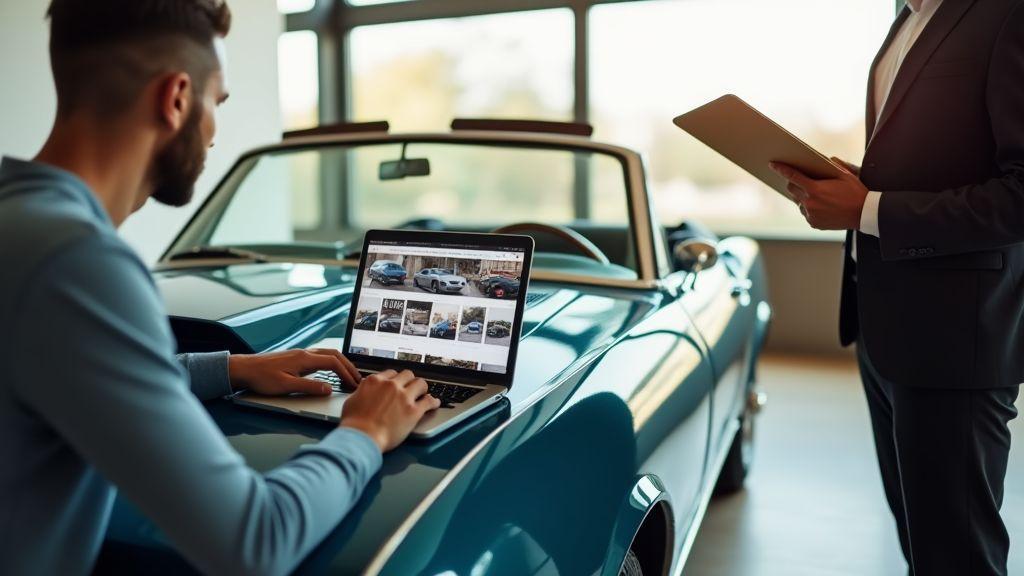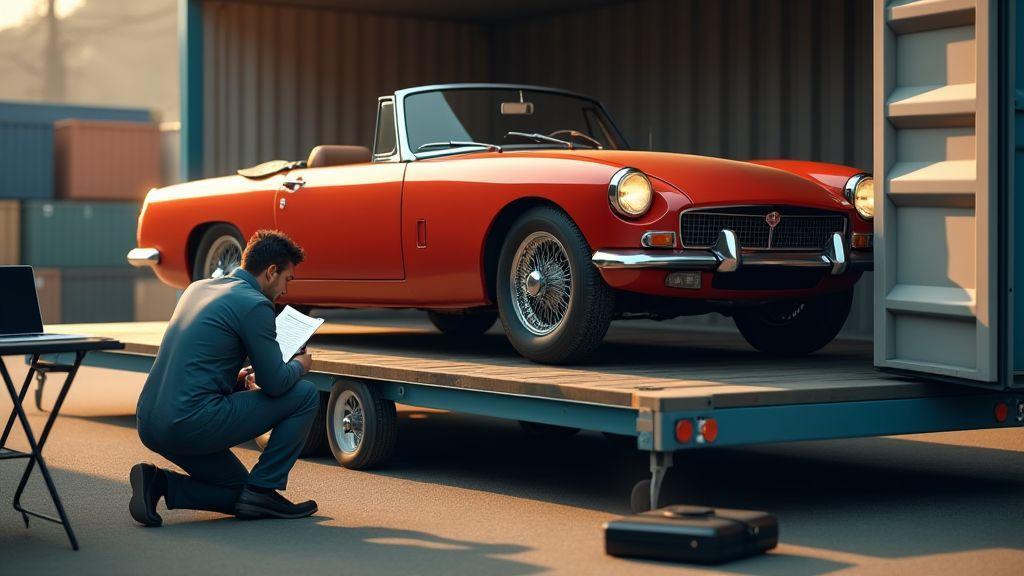Best Websites to Buy and Sell Classic Cars Online
Best Websites to Buy and Sell Classic Cars Online shows where to buy or sell your vintage ride and how to do it safely. You’ll compare marketplaces and fees, learn how dealers set prices and list cars, and get a quick checklist for choosing a platform. The guide explains auctions, buyer premiums, reserve prices, live and timed bidding, and safety steps to protect your money. You’ll also find how to locate trusted dealers, verify VIN and history, order inspections, arrange shipping and escrow, and finish paperwork for title and registration.
Key Takeaway
- Check seller reputation and read buyer reviews.
- Pull full vehicle history reports.
- Hire an inspector or see the car in person.
- Use secure payment and clear shipping terms.
- Set a firm budget and watch for hidden fees.

Best Websites to Buy and Sell Classic Cars Online for top marketplaces you can use
You want the Best Websites to Buy and Sell Classic Cars Online, and the field breaks into a few types: auction sites, classifieds, and dealer/consignment networks. Auction sites like Bring a Trailer draw serious bidders for rare cars and often set high market prices. Classifieds such as Hemmings and Facebook Marketplace give broad reach for barn finds and everyday classics. Dealer networks and consignment platforms like ClassicCars.com and specialized dealers offer hands-off sales with extra polish and buyer trust.
Each site attracts a different crowd. Bring a Trailer is for detail-oriented bidders who enjoy dramatic auctions. eBay Motors gives global reach but more tire‑kickers. Hemmings and ClassicCars.com attract collectors who care about history and paperwork. Pick a site that matches your goal: a fast local sale, a high-price auction, or a curated collector sale.
Think of your car like a song on the radio — choose the right station. Rare cars with solid records do better on BaT or ClassicCars; runners or projects move quickly via Facebook or Craigslist. If you hate haggling, a dealer consignment can handle the details for a fee.
Compare classic car marketplaces online by listings and fees
Listings vary. Some sites show thousands of cars daily; auction sites list fewer but more desirable cars. Hemmings and ClassicCars.com offer steady classified-style listings with filters; Bring a Trailer and eBay run time-limited auctions that can spike prices.
Fees affect the math. eBay charges listing and final-value fees; auction houses add buyer or seller premiums; consignment dealers take commissions. Free local sites cost nothing but offer less protection. Match the fee model to the sale price — a 5% commission is reasonable on a $100k car but hurts on a $5k project.
How online classic car dealers list cars and set prices
Dealers list with proof: clear photos, video walk-arounds, VIN checks, service records, and inspection reports. They often pay for featured placement and email/social reach to get more eyeballs.
Pricing is part art, part data. Dealers study recent sales, auction results, and trends to set a starting price. They may price high to leave room for negotiation or set a firm price when demand is strong. Selling to a dealer outright usually yields a lower net price than consignment because dealers cover repair, storage, and sales risk.
Quick checklist to pick the right classic car sales platform
Check who buys there, fees, listing quality, whether the site helps with payment and shipping, buyer volume for similar cars, and available buyer protections. Match platform to your time, price goal, and comfort level.
How classic car auction sites work and how you should bid
Auction listings include photos, condition notes, and VINs. You register, often post a refundable deposit to bid, and can enter maximum bids so the system bids for you. Bids are live (real-time) or timed (over hours/days).
Bidding steps: choose a car, set your top price, and let proxy bidding or live participation handle the rest. Hammer price isn’t the full cost — add fees, taxes, and shipping. If you win, you’ll get an invoice with payment deadlines and delivery/pickup instructions.
Treat each lot like a mini test drive. Study photos, ask questions, and arrange an independent inspection or a video walkthrough. That prep keeps surprises low and your bidding rational.
Understand buyer premiums, reserve prices, and auction timelines
Buyer premiums are extra fees on top of the hammer price — factor them into your top bid. Reserve prices protect sellers: the car won’t transfer unless bids meet that minimum. Timelines matter — inspections close before sale, payment windows are short, and title-transfer deadlines vary. Mark dates on your calendar.
Live vs timed auctions and what that means for you
Live auctions are fast and can push prices up with momentum. If you attend live, set a firm budget and consider using an agent if you can’t be there in person. Timed auctions let you think and watch bids unfold over hours or days; last‑minute sniping can still change results. For timed lots, set a true top bid and stick to it.
Safety steps to bid on classic car auction sites
Verify seller and title, run the VIN through history checks, request recent photos or video walkarounds, use secure payment or escrow, avoid wiring money to individuals, read auction terms and fees, arrange independent inspections if possible, and plan pickup/shipping and insurance before you pay.

Finding trusted classic car dealers online and verifying sellers
Start with sites that focus on classics and check resources from the AACA resources for classic car buyers. A quick search for “Best Websites to Buy and Sell Classic Cars Online” will point you to major portals, but cross-check listings on forums and club pages to spot duplicates or inconsistencies.
Watch for red flags: refusal to share VIN, avoiding video calls, or pressing urgent wire transfers. Real dealers welcome inspections. Ask for test-drive footage, close-ups of rust-prone spots, and paperwork photos like title and bill of sale.
Make contact friendly but firm — ask specific questions about service history, parts sources, rust repairs, and mileage, and use a marketplace’s contact tools or a trusted resource such as the Meridian Pioneer contact page when you need a formal point of contact. Use escrow or a credit card for payment when possible. Treat the purchase like a house — verify paperwork, title, and get a second opinion before signing.
What certified listings and dealer guarantees really mean
“Certified” varies widely. Some dealer certifications are basic checklists; others use third‑party inspectors with detailed reports. Ask who did the inspection and read the report. Dealer guarantees differ too — a 30‑day parts-and-labor offer is not the same as a transferable year-long warranty. Get guarantees in writing.
Use reviews and dealer history to find trusted classic car dealers online
Check reviews across Google, Facebook, forums, and trade groups. Look for patterns — repeated complaints or praise are telling. Check how long a dealer has been in business, whether they show at major events, and whether past customers would buy again. If possible, call a past customer and ask one question: would you buy from them again?
Steps to confirm an online dealer is legitimate
Call the phone number, check the business address on Google Maps, verify the VIN with Carfax/AutoCheck, request an independent inspection, insist on a written contract and title history, and avoid wire transfers — prefer escrow or credit card.
How to verify classic car listings for sale using VIN and history
Start with the VIN — it’s the car’s fingerprint. Run a free VINCheck search online to detect salvage, flood, or theft brands, then run it through multiple services, look for title brands like salvage or flood, and match the VIN stamped on the chassis to documents and listing photos. If anything doesn’t match, consider it a red flag.
Use NHTSA’s VIN decoder tool to confirm factory specs and decode options, and use at least two history providers and check marque registries or club databases for notable cars. Sellers on the Best Websites to Buy and Sell Classic Cars Online often upload reports and build sheets, but you still need to read the fine print. VIN tag, engine number, and dash plate photos are more valuable than a glossy sales blurb.
Think like a detective: ask for scanned documents, date‑stamped photos, and an ownership timeline. If the seller resists these questions, walk away or hire a third‑party inspector.
Run vehicle history reports and check title status before you buy
Pull a vehicle history report and read every section for title brands, accident records, mileage gaps, and owner count. For older classics also check marque registries, DMV records, and insurance histories when possible.
Verify title status with the state DMV. Titles marked salvage, rebuilt, or flood affect value and risk. If the title is out of state or VINs have changed, ask for official explanations. Clean, matching documents are a green light; mismatches need answers.
Look for documented provenance and service records in listings
Provenance proves what the car has been through. Listings that include original bills of sale, build sheets, restoration invoices, and receipts give a clear map of a car’s life. Small service stamps show steady care; big invoices reveal major work.
Ask for scans, dates, and shop names. Call the shops if you can. Competition history, trophies, and photos add value. Lack of paperwork doesn’t doom a purchase, but it raises risk and should lower your offer.
Required documents to confirm a classic car’s authenticity
You should see:
- Clear title or release
- Bill of sale with dates and signatures
- VIN photos and build sheet/factory data tag
- Service invoices and receipts
- Registration history and previous appraisals or condition reports
- Notarized transfer papers if applicable
- Any marque club or event records that tie the car to its past

Shipping, inspections, and escrow when you buy classic cars online
Buying online is exciting but detail‑driven. Treat the listing as step one — photos, seller notes, and VIN checks give clues but can’t replace hands‑on checks, safe payment, and a transport plan; follow the FTC guidance on buying a car for secure payment and escrow best practices.
Line up an independent inspection, book a shipper who knows old cars, and use a secure payment method that holds funds until you’re satisfied. If the seller resists an inspector or escrow, that’s a red flag. Cover inspections, shipping, and escrow to make your purchase confident rather than risky.
Order an independent pre‑purchase inspection before payment
Get an inspector who works for you. Independent inspectors drive the car, verify numbers, check for hidden rust, and test brakes and electrics. A good report includes photos, repair lists, and a roadworthiness statement.
Book early, pay the inspector directly, and ask for a video of the test drive and close-ups. Use the report to renegotiate or walk away. Never hand over full payment without a recent, independent inspection report.
Arrange transport and insurance through experienced car shippers
Choose shippers that treat classics like antiques: enclosed transport, experienced handlers, and good collector references. Ask about pickup/delivery windows, securing methods, and whether they use soft straps or wheel nets to avoid paint damage.
Document the car’s condition with photos, remove loose parts, and note fluid levels. Confirm the shipper’s insurance limits and consider add-on transit coverage for high-value cars.
Use escrow and secure payment methods to protect your purchase
Use a reputable escrow service to hold funds until you confirm the car arrived as promised. Read the escrow agreement, note inspection/delivery timelines, and never release funds until you’ve completed your review.
Pricing, negotiation, and avoiding scams on vintage car classifieds
Pricing a classic blends data and judgment. Check recent sales for the same model, year, and condition. Adjust for rust, missing parts, or fresh restorations. Market price minus repair and transport costs gives a sensible ceiling.
When negotiating, be factual. Cite findings and estimates — rust, interior wear, or missing paperwork — and offer a fair first bid with room to move. Sellers respect numbers. Beware pressure tactics or requests for wire transfers; those are red flags.
Scams hide in classifieds. Cross‑check listings on the Best Websites to Buy and Sell Classic Cars Online to spot copy‑paste ads. Ask for clear photos, recent running video, and the VIN up front. Never send money without seeing the car or using traceable escrow or bank methods. If something feels off—missing title, vague answers, or stock photos—step back.
Use comparable sales and price guides to set a fair offer
Find apples‑to‑apples comps using classifieds, auction results, and price guides like Hagerty and NADA. Match year, engine, transmission, trim, and condition. Factor in local price differences and transport costs.
Build your offer: fair market value minus estimated repairs, parts, and transport. Start lower than your top price but stay reasonable. Back up your numbers with links or printouts to keep negotiations factual.
Watch for common red flags in vintage car classifieds and listings
Vague descriptions, stock images, inconsistent details, refusal of inspection, dodged VIN questions, and fast-payment pressure are warning signs. Listings priced far below market often hide serious problems.
Run the VIN, request a video of the car running, and get maintenance/restoration records. Use a local inspection service if you can’t attend. Prefer escrow or bank checks over anonymous wire transfers. If the seller gets defensive, walk away.
Final steps for paperwork, registration, and title transfer
Secure a signed bill of sale, properly assigned title, and VIN verification if required. Check for title brands and get lien releases. Complete odometer disclosure and any required state inspections. Make copies and register the car promptly so you can insure and drive it legally.
Conclusion
You’re set to buy or sell with eyes wide open. Pick the right marketplace for your goals — auction, classified, or consignment — and know how fees and commissions change the math. Match the car to the audience and you’ll get the right signal.
When auctions call, don’t get swept away. Account for buyer premiums, reserve prices, taxes, and shipping before you bid. Do the homework: read photos and notes like a map and set a firm top price.
Protect yourself: verify the VIN, pull multiple history reports, order an independent inspection, and use escrow or a secure payment method. Arrange enclosed shipping and insurance. Treat paperwork — title, bill of sale, lien releases — as your last line of defense.
Play it smart. Use comparables, ask blunt questions, and walk away from pressure or vague answers. A little stubbornness now saves a long, expensive headache later. For more practical tips and deep dives, read more at the Meridian Pioneer home page and keep your next classic dream rolling.

